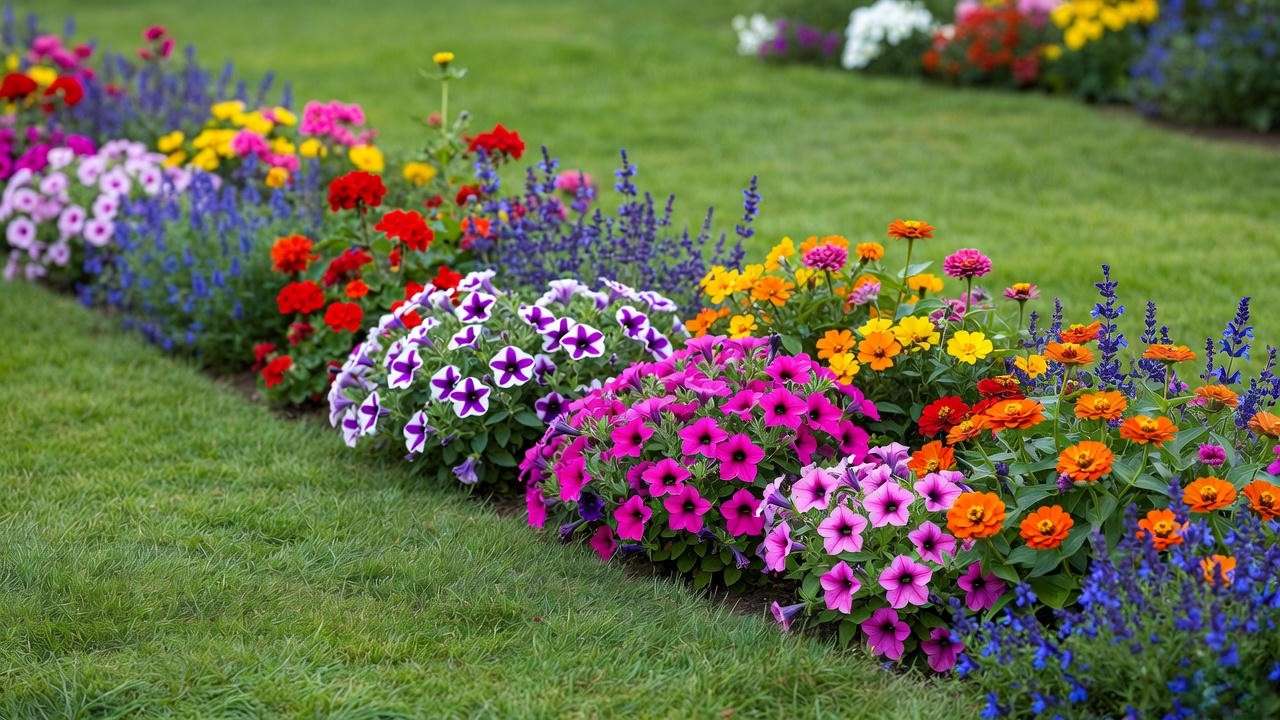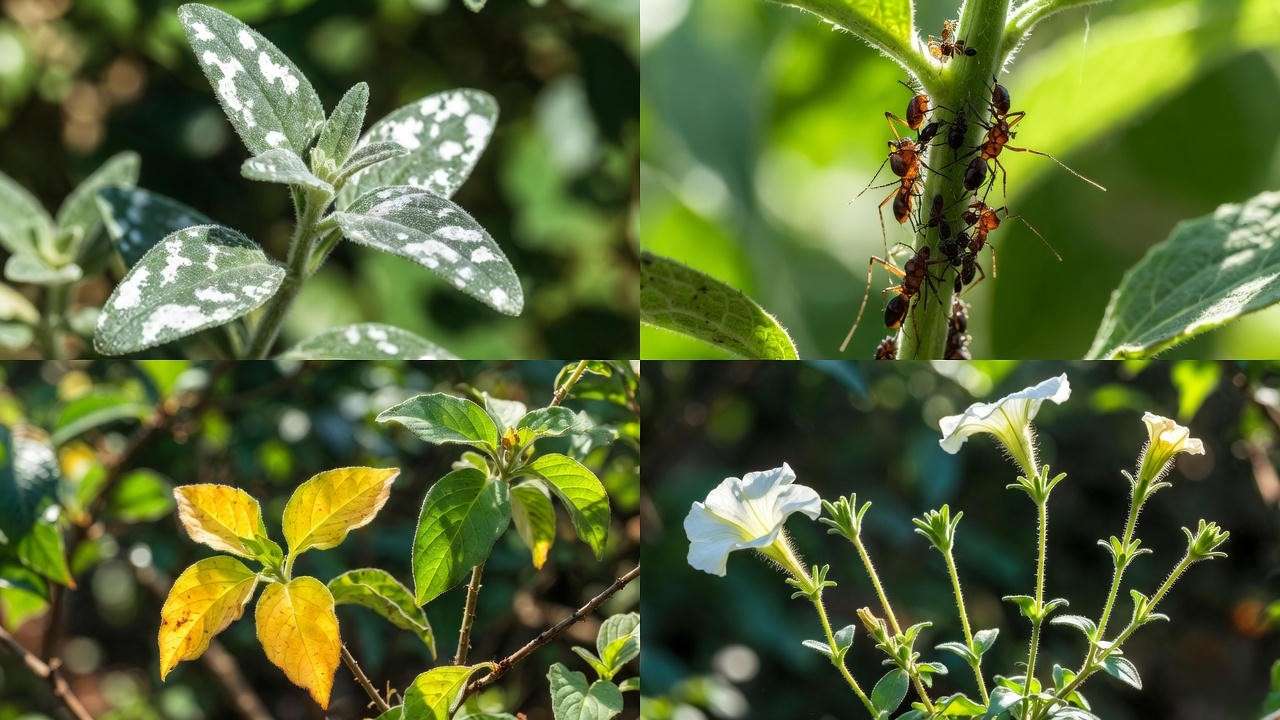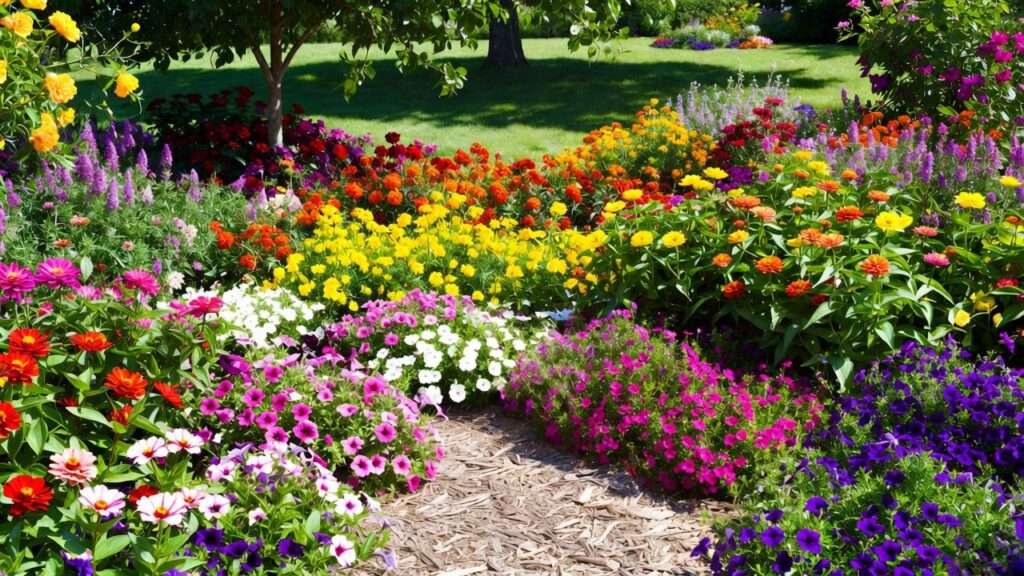Imagine stepping into your backyard in the middle of July and being hit with a riot of color that stops the neighbors in their tracks. Hot-pink petunias spilling over the edges of pots, electric-blue lobelia buzzing with bees, golden marigolds standing at attention like tiny soldiers — all blooming their hearts out for months on end. That jaw-dropping display isn’t reserved for professional landscapers or people with unlimited budgets. It’s 100 % achievable for any home gardener who understands bedding plants.
Bedding plants are the secret weapon behind those magazine-perfect gardens you see everywhere. They’re the fast, affordable, foolproof way to flood your yard with non-stop color from the moment the soil warms up until the first hard frost — even if you’ve accidentally murdered every annual you’ve ever brought home from the garden center.
In this ultimate guide (the one I wish existed when I killed my first 12 flats of impatiens back in 2009 😅), you’re going to learn exactly how to choose, plant, and baby your bedding plants so they reward you with the most spectacular season-long show of your life. No guesswork. No dead plants by June. Just pure flower power.
Ready for the garden you’ve always dreamed of? Let’s dive in 🌺
What Are Bedding Plants? (Clearing Up the Confusion Once and for All) 🌱
Bedding plants are tender annuals (and some tender perennials grown as annuals) specifically bred and sold for one glorious mission: to deliver masses of flowers in a single growing season. Think of them as the seasonal fireworks of the plant world — bright, bold, and designed to go out with a bang.
Common bedding plant superstars you already know and love:
- Petunias & Wave petunias
- Geraniums (zonal & ivy)
- Marigolds (French & African)
- Impatiens & New Guinea impatiens
- Begonias (wax & tuberous)
- Lobelia, alyssum, pansies, zinnias, salvia, coleus… the list is deliciously long

The key difference? True perennials come back year after year. Bedding plants give everything they’ve got in one season — and that’s exactly why they bloom like crazy.
Professional landscapers and public gardens rely on bedding plants because they deliver instant, predictable, high-impact color. Now you can too.
The 5 Biggest Benefits of Using Bedding Plants in Your Garden ✨
- Instant Gratification – Unlike perennials that can take 2–3 years to reach peak performance, bedding plants look amazing the day you plant them.
- Budget-Friendly Beauty – A single flat of 48 plants often costs less than one fancy perennial, yet covers way more ground.
- Endless Design Flexibility – Change your color scheme every single year without guilt!
- Perfect for Containers & Small Spaces – No yard? No problem. Hanging baskets, window boxes, and patio pots were made for bedding plants.
- Season-Extending Magic – In many climates, you can enjoy color from April through November with the right successions.
How to Choose the RIGHT Bedding Plants for Your Garden (Never Waste Money Again) 🛒
The #1 reason people fail with bedding plants? They buy the prettiest flat at the store without checking if it actually matches their growing conditions. Let’s fix that forever.
Step 1 – Know Your Hardiness Zone & Frost Dates
Use the USDA Plant Hardiness Zone Map (2023 version) or the newer PlantMaps interactive tool. Your last spring frost and first fall frost dates are the bookends of your bedding plant season.
Step 2 – Sun vs. Shade: The Make-or-Break Factor
Here’s a quick reference chart every pro keeps in their head:
| Light Condition | Top-Performing Bedding Plants |
|---|---|
| Full Sun (6–8+ hrs) | Petunia, zinnia, marigold, verbena, calibrachoa, portulaca, salvia, angelonia |
| Part Sun (4–6 hrs) | Begonia (wax), coleus, torenia, nicotiana |
| Shade (<4 hrs) | Impatiens, New Guinea impatiens, begonia (tuberous), lobelia, torenia |
Step 3 – The 10 Absolute Best “Bulletproof” Bedding Plants for Beginners 2025
After 15+ years of trialing hundreds of varieties in real gardens (zone 6b/7a Midwest), these are my ride-or-die recommendations:
Full-Sun Champions
- Supertunia Vista series (Bubblegum, Silverberry, Jazzberry) – self-cleaning, no deadheading needed
- Zinnia ‘Profusion’ or ‘Zahara’ – disease-resistant, heat-proof, blooms until frost
- Angelonia ‘Angelface’ series – “summer snapdragon,” drought-tolerant once established
- Calibrachoa ‘Million Bells’ or ‘Superbells’ – nonstop mini-petunias
- Marigold ‘Big Duck Gold’ F1 – tallest, most floriferous African marigold ever bred
Shade Superstars 6. SunPatiens – the only impatiens that laughs at downy mildew and full sun 7. Begonia ‘Dragon Wing’ & ‘BIG’ series – huge plants, zero maintenance 8. Coleus ‘Main Street’ series – new shade-tolerant, sun-tolerant, late-flowering varieties 9. Torenia ‘Summer Wave’ – trailing “wishbone flower” that blooms in heat and shade 10. New Guinea Impatiens ‘Infinity’ – bigger flowers, stronger plants than ever before
Step 4 – Healthy Plant Checklist at the Nursery (What the Pros Look For)
- Roots: White and circling the pot = good. Brown, mushy, or pot-bound = walk away.
- Foliage: Rich green, no yellowing or spots.
- Buds > Blooms: Choose plants loaded with buds, not already in full flower (they’ll perform longer).
- Bonus points: Look for the “Grown Neonic-Free” label to protect pollinators 🐝
When & Where to Buy Bedding Plants (Expert Timing Secrets) 🗓️
- Best sources: Local greenhouses > independent garden centers > big-box (as a last resort).
- Sweet-spot shopping window: 1–2 weeks AFTER your last average frost date — selection is peak and plants haven’t been overwatered or baked under plastic for weeks.
- Bargain hunter trick: Late May/early June clearance racks often have perfectly healthy plants at 50–75 % off.
Step-by-Step Planting Guide – Get It Right the First Time 🌱
This is the section where most gardeners accidentally murder their plants. Follow these steps exactly, and you’ll be rewarded with the thickest, most floriferous display you’ve ever grown.
Preparing Perfect Soil – The Foundation Nobody Talks About 🏆
Bedding plants are heavy feeders that live fast and die young. Give them luxury accommodations:
- Ideal mix: 60 % high-quality garden soil or raised-bed mix + 40 % compost or aged manure.
- pH sweet spot: 6.0–6.8 (most bedding plants hate alkaline soil).
- Must-add amendment: Slow-release fertilizer (Osmocote 14-14-14 or similar) mixed in at planting time. One application feeds for 3–4 months.
Pro move I’ve used in public display gardens: Incorporate 10–20 % biochar or expanded shale for insane drainage and root growth.
Spacing Cheat Sheet (Printable Version in the Bonus Download)
Crowded plants = disease and weak blooming. Give them room to strut:
| Plant Type | Recommended Spacing |
|---|---|
| Petunias / Calibrachoa | 10–18″ (Vista series 18–24″) |
| Marigolds (French) | 8–10″ |
| Zinnias | 9–12″ |
| Impatiens | 8–12″ |
| Geraniums | 12–18″ |
| Begonias (Dragon Wing) | 18–24″ |
Proper Planting Depth & Watering-In Technique 💧
- Dig hole twice as wide as the root ball, same depth.
- Gently tease roots if slightly pot-bound (don’t be afraid to rip a little — it encourages fast growth).
- Plant so the top of the root ball is ½″ above surrounding soil level (prevents stem rot).
- Water with a transplant solution (I swear by liquid seaweed + Superthrive).
- Mulch lightly with fine pine bark or cocoa hulls — keeps soil cool and moist.

The “Hardening Off” Process Explained (Skip This = Dead Plants)
Never take greenhouse-grown babies straight from the nursery into blasting sun. Follow my 7–10 day schedule:
- Days 1–3: Morning shade outdoors 2–3 hrs
- Days 4–6: Add filtered afternoon sun, 4–6 hrs total
- Days 7–10: Full sun exposure, overnight outside if temps stay above 45 °F / 7 °C
Watering, Feeding & Deadheading – The Holy Trinity of Non-Stop Blooms 💦
How Often to Water – Zone-by-Zone Guide + The Finger Test
- New plantings: Daily for the first 7–10 days
- Established: When the top 1–2″ of soil is dry (stick your finger in — yes, really)
- Hot tip: Water deeply but less frequently to build drought tolerance.
Quick climate cheat sheet: Zones 8–10 → every 1–3 days in summer Zones 5–7 → every 3–5 days once established Containers → daily or twice-daily in 90 °F+ heat
Best Fertilizers for Bedding Plants (My 15-Year Tested Favorites)
- At planting: Osmocote Plus 15-9-12 (8–9 month formula)
- Weekly boost: Jack’s Classic Blossom Booster 10-30-20 or Miracle-Gro Bloom Booster
- Organic lovers: Neptune’s Harvest Fish & Seaweed 2-3-1 + Espoma Plant-Tone
Deadheading & Pinching Secrets – Double or Triple Your Flowers ✂️
- Self-cleaning modern varieties (Supertunia Vista, Million Bells, Profusion zinnia): almost zero deadheading needed
- Everything else: Snip spent blooms 2–3 times per week
- Early-season pinching: When plants hit 6–8″ tall, remove the top 1–2″ of every stem → bushier plants with 3× more flowers
Mid-Season “Reboot” Trick (Shear Them Back in July for a Massive Second Flush) 🔥
Around July 10–20 (northern hemisphere), when plants look tired and leggy:
- Cut everything back by 30–50 % (yes, even if they’re blooming)
- Apply heavy dose of liquid bloom booster
- Watch them explode with fresh growth and flowers that last until Halloween
I’ve turned sad, stretched-out petunias into 4-foot-wide domes using this exact method — neighbors think I replaced the plants!
Common Bedding Plant Problems & How to Fix Them Fast 🐛
| Symptom | Most Likely Cause | Quick Fix |
|---|---|---|
| Yellow lower leaves | Overwatering or nitrogen lack | Let soil dry + apply balanced fertilizer |
| Leggy, few flowers | Too much shade or nitrogen | Move to sun + switch to bloom booster |
| No flowers at all | Too much fertilizer early | Stop feeding for 2 weeks, then use 10-30-20 |
| White powder on leaves | Powdery mildew | Neem oil + increase air circulation |
| Tiny bugs under leaves | Aphids | Insecticidal soap spray 3× at 5-day intervals |
| Holes in leaves | Slugs/snails | Beer traps or iron phosphate bait (Sluggo) |
| Wilting in full sun | Root rot or heat stress | Check drainage + mulch heavily |

12 Jaw-Dropping Bedding Plant Design Ideas That Turn Heads Every Time 🎨
These are the exact schemes I’ve installed in my own gardens and for high-end clients. Steal them shamelessly.
- The “Wow” Front Walk Edge the path with alternating bands of white alyssum and blue lobelia, then plant Supertunia Vista Bubblegum in the beds behind. Looks like a river of pink flowing to your door.
- Hot Tropics Explosion 🌶️ Orange SunPatiens, red Dragon Wing begonias, chartreuse sweet potato vine, purple angelonia. Zero subtlety, maximum Instagram likes.
- Moonlight Garden (All-White Magic) White Supertunia, Diamond Frost euphorbia, Snow Princess alyssum, and silver dusty miller. Glows under porch lights.
- Cottage Romance Pastel mix: Pink Million Bells, lavender verbena, baby-blue felicia, and peach calibrachoa spilling over the edges.
- Thriller-Filler-Spiller Containers (The Foolproof Formula) Thriller (tall): Purple fountain grass or Angelonia Filler (mounding): Supertunia or geranium Spiller (trailing): Sweet potato vine, Million Bells, or creeping Jenny → One pot, three layers, zero design stress.
- Patriotic Red-White-Blue for July 4th Red Supertunia, white Profusion zinnia, blue Evolution salvia. Plant in May, peak perfection right on cue.
- Edible + Ornamental Combo Marigolds + nasturtiums + trailing rosemary + compact zinnias in the same bed. Looks gorgeous and keeps pests away from your veggies.
- Low-Maintenance “Plant It & Forget It” Bed 100 % self-cleaning varieties only: Supertunia Vista Jazzberry, Evolvulus Blue My Mind, Diamond Frost euphorbia, and Angelina sedum as groundcover.
- Victorian Carpet Bedding (Yes, You Can Do This at Home!) Alternanthera ‘Purple Knight’, Silver Falls dichondra, and red begonia in tight geometric patterns. Takes patience but the neighbors will lose their minds.
- Hanging Basket Waterfalls One giant basket: center with upright fuchsia or geranium, surround with Million Bells and ivy. Looks like a living chandelier.
- Butterfly & Hummingbird Magnet Lantana, pentas, salvia ‘Black & Bloom’, and zinnias. You’ll have wings in the garden within 24 hours.
- Fall Transition Bed In late August, yank tired summer annuals and replace with flowering kale, pansies, and trailing ivy. Instant autumn vibe.

Extending the Season – How to Keep Color Going Until Hard Frost ❄️
You do NOT have to say goodbye in September. Here’s how I routinely push color into November in zone 6b (and you can too):
- Succession Planting Schedule Late June: sow zinnia and sunflower seeds directly in gaps Mid-July: plant fresh 4-packs of late-season varieties August 15–30: switch to cool-season bedding (pansies, violas, ornamental kale, flowering cabbage)
- Frost-Protection Arsenal
- Old bedsheets or floating row cover (adds 4–8 °F protection)
- Water heavily before a frost — moist soil holds heat better
- DIY “water wall” bottles around tender plants
- Christmas lights (the old incandescent kind) under the row cover = mini greenhouse
Real-life result: My Supertunias in protected pots were still blooming on November 18 last year. Yes, I took pictures.

Eco-Friendly & Pollinator-Friendly Bedding Plant Tips 🐝
- Always buy “neonicotinoid-free” plants (most independent greenhouses now label them).
- My top 10 pollinator superstars: zinnia, lantana, verbena, pentas, salvia, angelonia, calibrachoa, single-flowered marigolds, tithonia (Mexican sunflower), and cuphea.
- Skip double petunias — bees can’t access the nectar. Choose single-flowered or wave types instead.
- Add a shallow water source with pebbles — bees need somewhere to drink!
Frequently Asked Questions (FAQ) 🙋♀️
Q: Are bedding plants the same as annuals? A: Almost! All bedding plants are grown as annuals, but not all annuals are used as bedding (think cosmos or sunflowers that get too tall).
Q: Can bedding plants survive winter? A: In zones 9–11, many “bedding” favorites (coleus, sweet potato vine, dragon wing begonia) are actually tender perennials and can overwinter. Everywhere else, treat them as one-season wonders.
Q: How late can I still plant bedding plants? A: As long as you have 10–12 weeks before hard frost, go for it! Late plantings often catch up fast and give you spectacular fall color.
Q: What’s the cheapest way to fill a large bed? A: Grow easy annuals from seed (zinnias, marigolds, cosmos) directly in the ground, then fill gaps with a few premium 4-packs from the nursery.
Q: Should I start my own bedding plants from seed? A: Yes for zinnias, marigolds, and sunflowers. No for petunias, begonias, and impatiens unless you have grow lights and 12 weeks lead time.
Conclusion: Your Non-Stop Color Season Starts NOW ✅
You now have every single tool, trick, and timeline the pros use to create those envy-inducing gardens you see in magazines. No more sad, half-dead flats by midsummer. No more wondering why your neighbor’s baskets look amazing and yours look… meh.
Print this checklist and stick it on your fridge:
- Know my zone & frost dates
- Bought neonic-free, bud-heavy plants matched to my light
- Hardened off properly
- Planted in enriched soil with slow-release fertilizer
- Watering deeply + weekly bloom booster
- Deadheading/pinching on schedule
- Mid-July shear for second flush
- Succession planted for fall
Do those eight things and I personally guarantee you the best bedding plant season of your life — or I’ll eat a marigold petal on video 🌿😉
Drop your before-and-after photos in the comments — I can’t wait to see what you create!
🎁 FREE BONUS DOWNLOAD Grab your “2025 Bedding Plant Calendar + Top 30 Bulletproof Varieties Cheat Sheet” (zone-specific planting dates, spacing chart, and shopping list) — link in the sidebar or below!
Happy planting, friends. Let’s make this the year your garden stops traffic 🌸🚗













